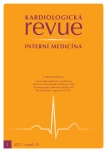Late consequences of cardiotoxicity
Authors:
L. Elbl
Authors‘ workplace:
Privátní kardiologická ambulance, Brno
Published in:
Kardiol Rev Int Med 2017, 19(1): 22-29
Overview
Advances in oncological treatment have led to improved survival of patients with cancer, but have also increased morbidity and mortality due to the treatment side effects. Cardiovascular diseases are among the most frequent of these side effects, and there is a growing concern that they may lead to premature morbidity and death among cancer survivors. This may be caused by cardiotoxicity, which involves the direct effects of cancer treatment on heart function and structure, or by accelerated development of cardiovascular diseases, especially in the presence of traditional cardiovascular risk factors. The most common side effects of anti-cancer treatment include vasospastic and thromboembolic ischaemia, arterial hypertension, arrhythmia, and cardiac dysfunctions that may lead to heart failure. Although the issues related to cardio-oncology have received increasing attention in recent years, many aspects of both radiation-induced and cancer drug-induced cardiovascular disease remain to be fully elucidated. Furthermore, the inability to predict the long-term consequences of cardiovascular side effects of cancer treatment leads to under- or over-diagnosis of cardiovascular diseases, sometimes resulting in the failure to prevent adverse events and sometimes leading to inappropriate interruption of a potentially life-saving cancer treatment.
Keywords:
late cardiotoxicity – chemotherapy – radiotherapy – cardio-oncology
Sources
1. Curigliano G, Cardinale D, Dent S et al. Cardiotoxicity of anticancer treatments: epidemiology, detection, and management. Cancer J Clin 2016; 66(4): 309– 325. doi: 10.3322/ caac.21341.
2. Cuomo JR, Sharma GK, Conger PD et al. Novel concepts in radiation-induced cardiovascular disease. World J Cardiol 2016; 8(9): 504– 519.
3. Zamorano JL, Lancellotti P, Rodriguez Muñoz D et al. 2016 ESC Position Paper on cancer treatments and cardiovascular toxicity developed under the auspices of the ESC Committee for Practice Guidelines. Eur Heart J 2016; 37(36): 2768– 2801. doi: 10.1002/ ejhf.654.
4. Albini A, Pennesi G, Donatelli F et al. Cardiotoxicity of anticancer drugs: the need for cardio-oncology and cardio-oncological prevention. J Natl Cancer Inst 2010; 102(1): 14– 25. doi: 10.1093/ jnci/ djp440.
5. Jain M, Townsend RR. Chemotherapy agents and hypertension: a focus on angiogenesis blockade. Curr Hypertens Rep 2007; 9(4): 320– 328.
6. Yeh ET, Bickford CL. Cardiovascular complications of cancer therapy. J Am Coll Cardiol 2009; 53(24): 2231– 2247. doi: 10.1016/ j.jacc.2009.02.050.
7. Wu S, Chen JJ, Kudelka A et al. Incidence and risk of hypertension with sorafenib in patients with cancer: a systematic review and meta-analysis. Lancet Oncol 2008; 9(2): 117– 123. doi: 10.1016/ S1470-2045(08)70003-2.
8. Chu TF, Rupnick MA, Kerkela R et al. Cardiotoxicity associated with thyrosin kinase inhibitor sunitinib. Lancet 2007; 370(9604): 2011– 2019.
9. Liu B, Ding F, Liu Y et al. Incidence and risk of hypertension associated with vascular endothelial growth factor receptor tyrosine kinase inhibitors in cancer patients: a comprehensive network meta-analysis of 72 randomized controlled trials involving 30,013 patients. Oncotarget 2016; 7(41): 67661– 67673. doi: 10.18632/ oncotarget.11813.
10. Bovelli D, Plataniotis G, Roila F. Cardiotoxicity of chemotherapeutic agents and radiotherapy-related heart disease: ESMO Clinical Practice Guidelines. Ann Oncol 2010; 21 (Suppl 5): 277– 282. doi: 10.1093/ annonc/ mdq200.
11. Conen D, Wong JA, Sandhu RK et al. Risk of malignant cancer among women with new-onset atrial fibrillation. JAMA Cardiol 2016; 1(4): 389– 396. doi: 10.1001/ jamacardio.2016.0280.
12. Ostenfeld EB, Erichsen R, Pedersen L et al. Atrial fibrillation as a marker of occult cancer. PLoS One 2014; 9(8): e102861. doi: 10.1371/ journal.pone.0102861.
13. Ferreira C, Providência R, Ferreira MJ et al. Atrial fibrillation and non-cardiovascular diseases: a systematic review. Arq Bras Cardiol 2015; 105(5): 519– 526. doi: 10.5935/ abc.20150142.
14. Montani D, Bergot E, Gunther S et al. Pulmonary arterial hypertension in patients treated by dasatinib. Circulation 2012; 125(17): 2128– 2137. doi: 10.1161/ CIRCULATIONAHA.111.079921.
15. Shah NP, Wallis N, Farber HW et al. Clinical features of pulmonary arterial hypertension in patients receiving dasatinib. Am J Hematol 2015; 90(11): 1060– 1064. doi: 10.1002/ ajh.24174.
16. Madan R, Benson R, Sharma DN et al. Radiation induced heart disease: Pathogenesis, management and review literature. J Egypt Natl Canc Inst 2015; 27(4): 187– 193. doi: 10.1016/ j.jnci.2015.07.005.
17. Aleman BM, Moser EC, Nuver J et al. Cardiovascular disease after cancer therapy. EJC Suppl 2014; 12(1): 18– 28. doi: 10.1016/ j.ejcsup.2014.03.002.
Labels
Paediatric cardiology Internal medicine Cardiac surgery CardiologyArticle was published in
Cardiology Review

2017 Issue 1
Most read in this issue
- Diuretics and mineralocorticoid receptor antagonists in the therapy of chronic heart failure with reduced left ventricular ejection fraction
- COSYREL – a drug for patients with coronary artery disease and heart failure
- Rivaroxaban – pharmacological profile
- Late consequences of cardiotoxicity
